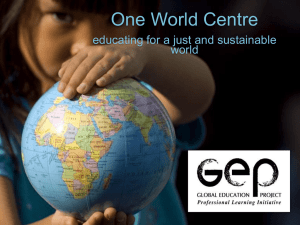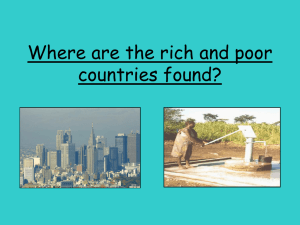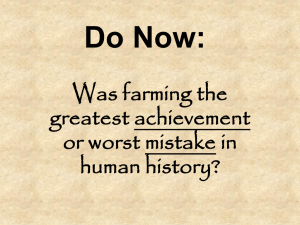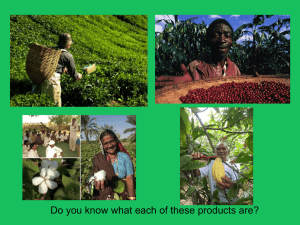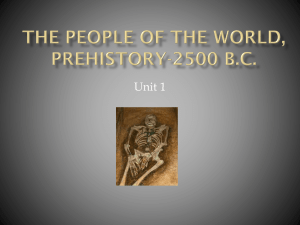File - Shefferly Science
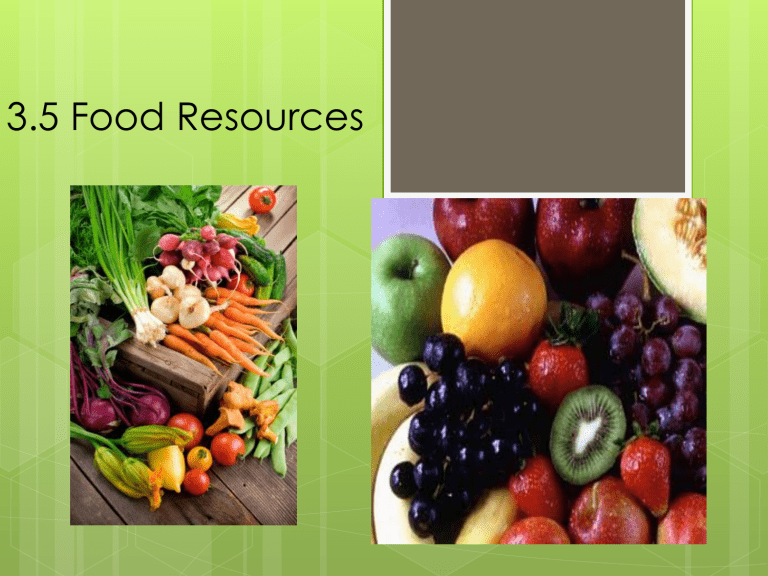
3.5 Food Resources
Food Issues
MEDC / LEDC
Food Production and Distribution
Imbalance in food distribution
Over 1 billion people are living in poverty and starving in LEDC countries
MEDC Average Caloric Intake = 3314
LEDC Average Caloric Intake = 2666
Causes:
Unequal distribution
Lack of access to clean water
Poor harvesting / farming practices (overgrazing/ overfishing)
Undernourishment worldwide
Food Waste
Terrestrial vs. Aquatic Food
Production Systems
VS
Aquatic Food Production
Aquatic Food Production:
Food is harvested from high tropic levels due to human preference (ex. salmon).
Photosynthesis is less efficient by producers due to light reflection of water
Terrestrial Food Production
Terrestrial Food Production:
Most food harvested from low tropic levels (producers
/ herbivores)
Energy conversions less efficient on land
Food Production affects the
Environment
Biodiversity
Soil
Water
Air
Human Health
Increasing food production output
GMO- Genetically Modified Organisms
Change genetic make up of living things to make them look, feel, and taste different
Pesticides- chemicals used to kill pest organisms
Herbicides- chemicals used to kill weeds
Fertilizers- chemicals used to grow larger crops
Irrigation- canals used to bring in more water
Antibiotics/ Growth Hormones- used to grow healthier and larger animals
Biodiversity Loss
Loss of grasslands forests and wetland for cultivation
Loss of genetic diversity (wild crops replaced with monocrops)
Soil
Erosion
Loss of fertility
Salinization
Desertification
Increase soil pH
Water
Waste water produced
Aquifer depletion from increased irrigation
Air
Large fossil fuel use in farming equipment causes release of greenhouse gases (CO2, N2O, and CH4)
Pesticide sprays
Human Health
Nitrates in Drinking water
Blue baby
Pesticides
Bacterial contamination of meat
(E. coli)
North American Cereal Farming vs.
Asian Subsistence Farming
Comparison Pair #1
North American
Cereal Farming
Inputs: Fertilizers, pesticides, fossil fuels, labor, sunlight, water equipment
Characteristics: Heavy use of fossil fuels, lots of farming technology, monocrops
(only one crop)
Socio- Cultural: Fast production, large amounts, lots of waste
Environmental impact: loss biodiversity
Outputs: Air pollution , water pollution, wheat/corn, lots of income ($$)
Asian Subsistence
Farming
Inputs: lots of human labor, water, sunlight
Characteristics: grow only enough to eat to feed family & community, low tech
Socio- Cultural: mostly
LEDC, poor
Environmental impact: maintains biodiversity, reduces pollution
Outputs: Usually mixed crops; corn, beans and squash (all in same field)
Intensive Beef Production vs.
Maasia Tribal Livestock
Comparison Pair # 2
MEDC- Intensive
Beef Production
LEDC- Maasai Tribal
Livestock
Inputs: Hormones, antibiotics, labor, cattle feed (corn), breeding stock of cattle
Characteristics: Many cattle in crowded area
Socio- Cultural: Fast production, large quantities, lots of waste/death
Environmental impact: disease, waste
Outputs: Air pollution, water pollution, beef, lots of income ($$)
Inputs: Labor, Cattle feed/ grazing grass
Characteristics: large herds of cattle, used as only food source
“Nomadic Herding”
Socio- Cultural: Cattle are
THE source of life (even used as currency)
Environmental impact: overgrazing, nomadic behavior
Outputs: meat, milk, blood
Salmon Farming in Norway vs. Rice-
Fish Farming in Thailand
Comparison Pair # 3
Salmon Farming in
Norway
Rice-Fish Farming
Thailand
Inputs: antibiotics, fish food, cages, labor
Characteristics: fish raised in large quantity
Socio- Cultural: MEDC, employs large number of workers
Environmental impact: growth of algae, water pollution
Outputs: salmon, water pollution
Inputs: labor, seed
Characteristics: fish and rice grown together in same, self sustaining ecosystem (fed by natural food chain)
Socio- Cultural: LEDC countries,
Environmental impact: reduces waste maintains biodiversity
Outputs: rice, fish, income
Slash and Burn/ Shifting
Cultivation
Slash and Burn / Shifting
Cultivation
Input: Labor, plow, oxen, seed
Characteristics: Tropical forest set on fire to clear the land & ash fertilizes soil. After land is used farmers repeat this process
Socio-cultural: Typically harvested food is sold in community, low population density
Environment: Loss of biodiversity, fertility, ecosystem production decreases
Output: Monocrop, air pollution, income


